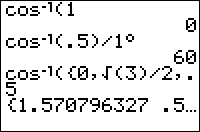TI-BASIC:Arccos
Command Summary
Returns the inverse cosine (also called arccosine)
Command Syntax
cosֿ¹(number)
Menu Location
Press:
- [2nd]
- [cosֿ¹]
TI-83/84/+/SE
1 byte
cosֿ¹( returns the arccosine of its argument. It is the inverse of Cos(, which means that cosֿ¹(n) produces an angle θ such that cos(θ)=n.
Like cos(, the result of cosֿ¹( depends on whether the calculator is in Radian or Degree mode. However, unlike cosine, the result is in degrees or radians, not the argument. A full rotation around a circle is 2π radians, which is equal to 360°. The conversion of θ=cosֿ¹(n) from radians to degrees is θ*180/π and from degrees to radians is θ*π/180. The cosֿ¹( command also works on a list.
The cosֿ¹( function can be defined for all real and complex numbers, but assumes real values only in the closed interval [-1,1]. Because Z80 calculators have their trigonometric functions and inverses restricted only to real values, the calculator will throw ERR:DOMAIN if the argument is outside of this interval, no matter what the mode setting may be.
In radians:
:cosֿ¹(-1)
3.141592654
In degrees:
:cosֿ¹(-1)
180
Advanced Uses
Since the function cosine itself doesn't have the restrictions that arccosine does, and since arccosine is the inverse of cosine, you can use cosֿ¹(cos( to keep a variable within a certain range (most useful for the home screen). Here is an example for a game like Pong. The ball travels between 0 and 12.
You could use a flag like this:
:If X=12 or not(X \\ X is the position :-D→D \\ D is the direction :X+D→X \\ new position :Output(8,X,"=
An easier way to do this, without needing a flag or even an If statement, is using cosֿ¹(cos(
:X+1→X \\ Note: the calculator is in Degree mode :Output(8,cosֿ¹(cos(15X))/15,"=") \\ I used 15 because cosֿ¹ ranges from [0,180] and X from [0,12], so 180/12=15
Error Conditions
- ERR:DOMAIN is thrown if you supplied an argument outside the interval [-1,1]
- ERR:DATA TYPE is thrown if you input a complex value or a matrix.
